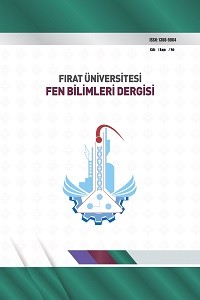Araştırma Makalesi
Yıl 2019,
Cilt: 31 Sayı: 1, 17 - 22, 27.09.2019
Öz
Metal içeren organik ve anorganik yapılarda elektron konfigürasyonu metalin çevresindeki ligand alan kuvvetine bağlı olarak değişebilmektedir. Bu durum üretilen malzemelerin spektroskopik özelliklerinin yanında manyetik ve elektriksel özelliklerini de güçlü bir şekilde etkilemektedir. Metal iyonunun yapısı ile birlikte son yörüngedeki elektronların dizilişi ve buna bağlı olarak metali çevreleyen ligandın kuvveti, orbitallerin yarılmasında en önemli parametrelerden biridir. Metal çevresindeki ligandların simetrik olmaması da eksensel olarak yarılma enerjilerini etkilemekte ve elde edilen komplekslerin özelliklerini değiştirmektedir. Metal-ligand bağ açısındaki çok küçük değişimler d orbitallerinin yarılmasını ve dolayısı ile elektronların dizilişini etkilemekte ve dolayısı ile manyetik ve UV özelliklerini kontrol etmektedir. Her iki açıdan da bu tür malzemelerin birçok eknolojik uygulamalarının ortaya çıkmasını sağlamaktadır.
Anahtar Kelimeler
Kaynakça
- [1] Alfredo T-F, Whetten RL, and Miguel J-Y. Ligand Effects on the Structure and the Electronic Optical Properties of Anionic Au25(SR)18 Clusters. J Phys Chem C 2013; 117: 20867-20875.[2] Kitchin JR, Nørskov JK, Barteau MA, and Chen JG. Role of Strain and Ligand Effects in the Modification of the Electronic and Chemical Properties of Bimetallic Surfaces. Phys Rev Lett 2004; 93: 156801.[3] Cotton FA, Carlos AM, Walton RA. Multiple Bonds between Metal Atoms. Springer-Verlag New York, 2005.[4] Brill AS. Transition Metals in Biochemistry. Springer-Verlag Berlin Heidelberg, 1977.[5] Poblet JM, López X and Bo C. Ab initio and DFT modelling of complex materials: towards the understanding of electronic and magnetic properties of polyoxometalates. Chem Soc Rev 2003; 32: 297-308.[6] Ohkoshi S-I, Imoto K, Tsunobuchi Y, Takano S and Tokoro H. Light-induced spin-crossover magnet. Nature Chem 2011; 3: 564–569.[7] Mazin II and Singh DJ. Electronic structure and magnetism in Ru-based perovskites. Phys Rev B 2006; 56: 2556.[8] Spain EM and Morse MD. Bond strengths of transition-metal dimers: titanium-vanadium(TiV), vanadium dimer, titanium-cobalt (TiCo), and vanadium-nickel (VNi). J Phys Chem 1992; 96: 2479–2486.[9] Ditchfield R. Molecular Orbital Theory of Magnetic Shielding and Magnetic Susceptibility. J Chem Phys 1972; 56: 5688.[10] Maki K. Effect of Pauli Paramagnetism on Magnetic Properties of High-Field Superconductors. Phys Rev 1996; 148: 362.[11] Manfred R. Challenges in Molecular Structure Determination. Friedrich-Schiller-Universität Jena, Springer, 2012.[12] Kallies B and Meier R. Electronic Structure of 3d [M(H2O)6]3+ Ions from ScIII to FeIII: A Quantum Mechanical Study Based on DFT Computations and Natural Bond Orbital Analyses. Inorg Chem 2001; 40: 3101–3112. [13] Launay J-P, Verdaguer M. Electrons in Molecules. From Basic Principles to Molecular Electronics, Oxford University Press, Oxford, 2013.[14] Jørgensen CK. Absorption spectra and chemical bonding in complexes. Pergamon, Oxford UK, 1962.[15] König E and Madeja K. Unusual magnetic behaviour of some iron(II)–bis-(1,10-phenanthroline) complexes. Chem Comm 1966; 3: 61-62.[16] Hauser A. Ligand field theoretical considerations. Top Curr Chem 2004; 233: 49-58.[17] Scepaniak JJ, Harris TD, Vogel CS, Sutter J, Meyer K, and Smith JM. Spin Crossover in a Four-Coordinate Iron(II) Complex. J Am Chem Soc 2011; 133: 3824–3827
Yıl 2019,
Cilt: 31 Sayı: 1, 17 - 22, 27.09.2019
Öz
Kaynakça
- [1] Alfredo T-F, Whetten RL, and Miguel J-Y. Ligand Effects on the Structure and the Electronic Optical Properties of Anionic Au25(SR)18 Clusters. J Phys Chem C 2013; 117: 20867-20875.[2] Kitchin JR, Nørskov JK, Barteau MA, and Chen JG. Role of Strain and Ligand Effects in the Modification of the Electronic and Chemical Properties of Bimetallic Surfaces. Phys Rev Lett 2004; 93: 156801.[3] Cotton FA, Carlos AM, Walton RA. Multiple Bonds between Metal Atoms. Springer-Verlag New York, 2005.[4] Brill AS. Transition Metals in Biochemistry. Springer-Verlag Berlin Heidelberg, 1977.[5] Poblet JM, López X and Bo C. Ab initio and DFT modelling of complex materials: towards the understanding of electronic and magnetic properties of polyoxometalates. Chem Soc Rev 2003; 32: 297-308.[6] Ohkoshi S-I, Imoto K, Tsunobuchi Y, Takano S and Tokoro H. Light-induced spin-crossover magnet. Nature Chem 2011; 3: 564–569.[7] Mazin II and Singh DJ. Electronic structure and magnetism in Ru-based perovskites. Phys Rev B 2006; 56: 2556.[8] Spain EM and Morse MD. Bond strengths of transition-metal dimers: titanium-vanadium(TiV), vanadium dimer, titanium-cobalt (TiCo), and vanadium-nickel (VNi). J Phys Chem 1992; 96: 2479–2486.[9] Ditchfield R. Molecular Orbital Theory of Magnetic Shielding and Magnetic Susceptibility. J Chem Phys 1972; 56: 5688.[10] Maki K. Effect of Pauli Paramagnetism on Magnetic Properties of High-Field Superconductors. Phys Rev 1996; 148: 362.[11] Manfred R. Challenges in Molecular Structure Determination. Friedrich-Schiller-Universität Jena, Springer, 2012.[12] Kallies B and Meier R. Electronic Structure of 3d [M(H2O)6]3+ Ions from ScIII to FeIII: A Quantum Mechanical Study Based on DFT Computations and Natural Bond Orbital Analyses. Inorg Chem 2001; 40: 3101–3112. [13] Launay J-P, Verdaguer M. Electrons in Molecules. From Basic Principles to Molecular Electronics, Oxford University Press, Oxford, 2013.[14] Jørgensen CK. Absorption spectra and chemical bonding in complexes. Pergamon, Oxford UK, 1962.[15] König E and Madeja K. Unusual magnetic behaviour of some iron(II)–bis-(1,10-phenanthroline) complexes. Chem Comm 1966; 3: 61-62.[16] Hauser A. Ligand field theoretical considerations. Top Curr Chem 2004; 233: 49-58.[17] Scepaniak JJ, Harris TD, Vogel CS, Sutter J, Meyer K, and Smith JM. Spin Crossover in a Four-Coordinate Iron(II) Complex. J Am Chem Soc 2011; 133: 3824–3827
Toplam 1 adet kaynakça vardır.
Ayrıntılar
| Birincil Dil | Türkçe |
|---|---|
| Bölüm | FBD |
| Yazarlar | |
| Yayımlanma Tarihi | 27 Eylül 2019 |
| Gönderilme Tarihi | 18 Mayıs 2018 |
| Yayımlandığı Sayı | Yıl 2019 Cilt: 31 Sayı: 1 |


